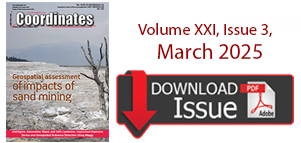| GNSS News | |
GNSS
|
||||||||||
Proposal for open source alternative to GPS
Philipp Ronnenberg, a masters student in design interactions at the Royal College of Art in London, recently showed off the first prototype sensors for his alternate “Open Positioning System,” which are designed to pick up regular seismic waves given off by large machinery in nearby power plants and factories. Once a sensor detects at least three different nearby seismic wave sources, Ronnenberg theorizes it should be able to determine its location. So far, he’s built a prototype sensor using the Arduino open source hardware microcontroller, which he says “can detect and collect different frequencies.” The project is currently in its infancy and Ronnenberg is seeking input from other interested beta testers on the Open Positioning System website. www.theverge.com/
First Glonass monitoring station in Brazil
The first overseas Glonass ground station for differential correction and monitoring toimprove thenavigation system’s accuracy is due tobe launched in Brazil, theFederal Space Agency announced. In Russia, such stations ensure accurate positioning in the northern hemisphere. Further stations must be built to improve theaccuracy of Glonass inthe western hemisphere. http://www.themoscowtimes.com/
Google, GPS cannot track illegal mining: Goa govt
Google satellite imaging and GPS are flawed when it comes to monitoring illegal mining and encroachment of forest land by mining companies, the Goa government has told the Supreme Court of India. “The reliance on Google imagery to allege encroachment is absolutely erroneous and technically unsound,” Principal Secretary (Mines) Rajani Kant Varma said in his affidavit before the apex court. The Supreme Court is hearing a public interest litigation on rampant illegal mining in the state filed by an NGO and activist-lawyer Prashant Bhushan. The Goa government now claims that there was a technical discrepancy in the Google maps software “with respect to altitude correction” and that handheld GPS surveys were “not accurate to precisely identify encroachment as these GPS have an inbuilt error”. http:// articles.timesofindia.indiatimes.com/
GLONASS pilot project in India
“We are testing the GLONASS technologies for an effective solution of the transport problems in India’s megapolises. We are shortly going to launch pilot projects in collaboration with Indian companies including Tata Consulting Service. These projects will be launched in megapolitan cities of Delhi, Mumbai and Bangalore. The introduction of the GLONASS technologies technologies in the public sector, like equipping the police personnel and vehicles with such systems is being seen as one of the prospective directions . Installation of GLONASS technologies in public transport is also being considered .” according to Mr. Aleksandr Bondarenko, Head of the representative office of the company “NIS GLONASS” in India. http://indian.ruvr. ru/2013_02_01/GLONASS-project-India/
A system that improves the precision of GPS in cities by 90 percent
Researchers at Universidad Carlos III de Madrid (UC3M) have developed a new system which improves the ability of a GPS to determine a vehicle’s position as compared to that of conventional GPS devices by up to 90 percent, and which can be installed in any vehicle at a very low cost. The system, which is based on sensorial fusion, was jointly designed and developed by the Applied Artificial Intelligence Group (GIAA – Grupo de Inteligencia Aplicada Artificial) and the Systems Intelligence Laboratory (LSI – Laboratorio de Sistemas Inteligentes) at UC3M. The prototype incorporates a conventional GPS signal with those of other sensors (accelerometers and gyroscopes) in order to reduce the margin of error in establishing a location. www.uc3m.es/
GPS Innovation Alliance launched
Citing the ever increasing importance of the GPS to the global economy and infrastructure, a group of GPS advocates have announced the formation of the GPS Innovation Alliance, an organization dedicated to furthering GPS innovation, creativity and entrepreneurship. Members of the Alliance are drawn from a wide variety of fields and businesses reliant on GPS. These include manufacturing, aviation, agriculture, construction, transportation, first responders and surveying and mapping. Still others are organizations representing consumers who depend on GPS for boating and other outdoor activities, and in their automobiles, smartphones and tablets. It is Headquartered in Washington, D.C. USA.
Introduction of GNSS/EGNOS1 in Africa
ASECNA (Agence pour la Sécurité de la Navigation Aérienne en Afrique et à Madagascar) in consortium with Egis, Pildo Labs and ESSP have been designated by the ACP Group (African, Caribbean and Pacific Group of States) to implement the SAFIR Project, funded by the European Commission through the 10th EDF Intra-ACP envelope, with the objective of building capacity within African ACP countries for the future deployment of GNSS/EGNOS in the region. The SAFIR (Satellite navigation services for AFrican Region) project will last two years and will cover the set-up, staffing and operations of an EGNOSAfrica Joint Programme Office (JPO) with a proper regional participation of the various beneficiary countries. The missions of the future JPO will be to define the baseline and oversee the subsequent implementation phase for the specification and procurement of the development and deployment of GNSS/EGNOS in Africa.











 (No Ratings Yet)
(No Ratings Yet)






Leave your response!